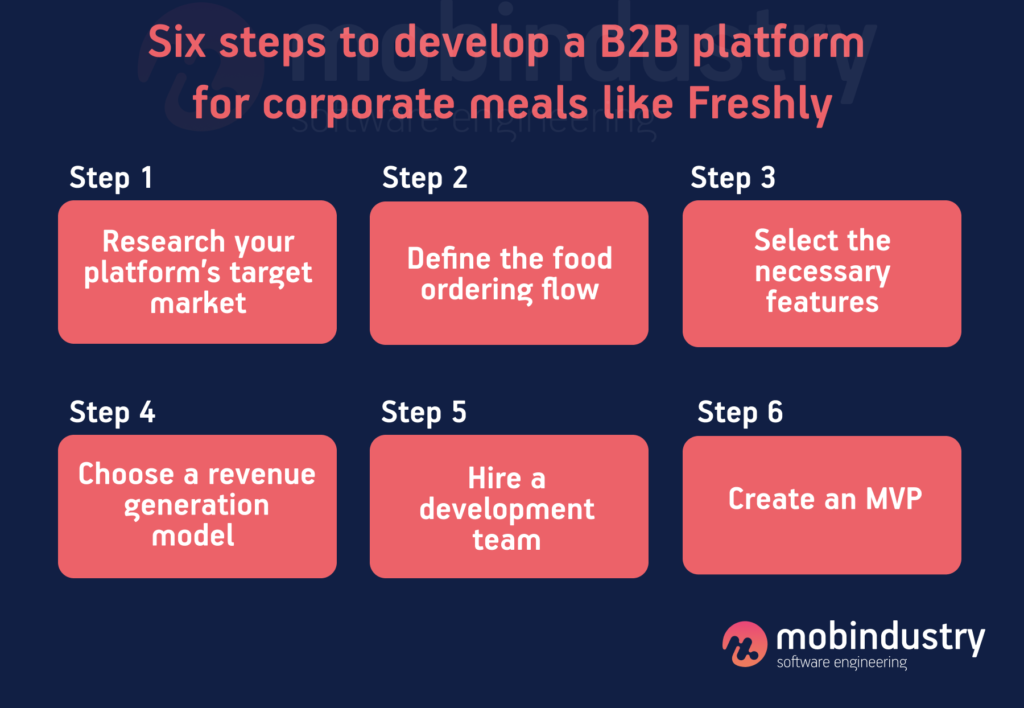How to Сreate a B2B Platform for Corporate Meals Like Freshly
Freshly is one of many home delivery services with a subscription-based access model available through a proprietary ecommerce platform. Subscribers receive fresh food to their doorstep so they can start or end their day with quick, quality meals that suit their tastes.
Online food delivery market statistics
The global online food delivery market in 2019 was worth $107.44 billion. This figure was expected to grow to $111.32 billion in 2020. The slow growth in 2020 was mainly caused by the slowdown in economic growth in various countries due to the coronavirus and measures to contain it. However, by 2023, the market is expected to grow by an average of 11.51 percent annually to reach $154.34 billion.
The forecast for Online Food Delivery Revenue

Online food delivery market statistics:
- Internet food delivery revenue is projected to reach $302.826 million in 2021.
- Revenue growth (CAGR 2021–2025) is expected to be 9.89%, leading to a projected market size of $441.622 million by 2025.
- The largest market segment is platform-to-consumer shipping, with a projected market size of $172,243 million in 2021.
- For comparison: Globally, most income will be generated in China in 2021 ($191,050 million).
- Average revenue per user (ARPU) from online food delivery is projected at $151.38 in 2021.
- The online food delivery segment is expected to have 2,897.1 million users by 2025.
How does Freshly work?

People buy meals directly on the Freshly website. First, a new customer must follow a simple account creation process. Then they are guided through a choice of dishes. Once they have made their choices, they select a delivery schedule and check out. Customers can choose from 6, 9, 12, or 21 dishes per week for an average of $11 each.
The good news for customers is that they don’t have to buy anything other than food. They also don’t need to worry about food waste. And to protect the environment, meals are packed and insulated with recyclable materials.
Freshly is designed for busy professionals and students, and portions are intended for individuals, not to feed a whole family.
This leads to the second advantage for subscribers. Freshly is a great meal plan for those who don’t want to waste time and money on ordering out. Subscribers not only save on fuel but also on food delivery costs that are usually charged by restaurants. Finally, subscribers can sample chef-made dishes that only need to be reheated and eaten.
Freshly’s value proposition
A value proposition is the value a company promises to customers. It is part of a company’s overall marketing strategy. Specifically, a value proposition is a statement of intent or a statement that introduces consumers to a company’s brand by telling them what the company is, how it works, and why it deserves their business.
Overall, Freshly sets itself apart from other popular competitors by offering precooked meals to subscribers. While competing services are great for home chefs who want to eat homemade meals prepared with unprocessed ingredients, Freshly subscribers would rather not bother with cooking at all.
Instead, they are promised meals that are not only prepared according to a chef’s recipes but are simply fresh and delicious.
Subscribers don’t need to worry about being over a hot stove at the end of the day.
Instead, they can take precooked food out of the refrigerator, heat it up, and eat it in minutes.
Freshly meals are similar in their convenience to the microwave-cooked meals found in traditional grocery stores. But unlike traditional microwave-cooked food, Freshly food is not delivered frozen (although it can be placed in the freezer if desired).
In addition, Freshly promises to use only fresh ingredients that are free from sodium and other preservatives. It remains to be seen how Freshly will continue to do this in an already crowded world of home delivery services. However, the industry itself is projected to continue growing.
Six steps to develop a B2B platform for corporate meals like Freshly
Here are six steps to create a B2B platform for corporate meals and simplify the development process.

1. Research your platform’s target market
When developing a B2B platform for corporate meals, the first thing you need to consider is your target audience. Understanding your users’ needs makes development easier and leads to a better final product. Find out as much as you can about your potential users. You can start by researching the following:
- Demographics. Find out the average age of your users, where they live, what devices they use, and so on.
- Behavioral trends. Find out what decreases a user’s desire to download an app, your users’ security expectations, and so on.
To develop an amazing mobile application, we suggest creating a user persona, or a detailed portrait of your ideal user.
2. Define the food ordering flow
For your future food delivery website to be successful, you must define how users will place orders. Most often, the flow includes the following stages:
- When a user visits a website to order food delivery, they use search functionality to select a restaurant, compare menus, and check prices and ratings. They then select the food and place the order.
- When the order is confirmed, the user logs in or creates a new account with their contact information and bank details.
- After placing the order, if the payment was successful, the user receives a notification that the order has been processed.
- Receiving a notification that an order has been processed is the end of the online scenario of a typical food ordering website. The rest of the steps, including food preparation and order delivery, are done offline.
3. Select the necessary features for your B2B platform for corporate meals

The choice of features for your future food delivery website is very important, as it will significantly impact the website’s usability. In most cases, the site needs to be configured for three user roles: user, restaurant, and administrator. All three should be connected to the website’s back end and work smoothly.
Below is a list of functions for these three user roles:
Customer
- Navigation menu
- Registration
- Sign up
- Place order
- Restaurant details
- Filter restaurants by cuisine
- Current offers
- Address book
- Rewards, loyalty, and coupons
Admin
- Admin login
- Restaurant management
- Website management
- Order management
- Technical payment
- Payment management
Restaurant Managers
- Sign in
- Search by food category
- Checkout process
- Choose payment method
- Order status and tracking
- Help & support
Your solution should inform restaurants of new orders as well as notify customers in the event that a restaurant has rejected an order, then suggest alternatives.
4. Choose a revenue generation model
The next step is to choose the right revenue model for your B2B platform for corporate meals. Now that you know your users’ needs, you can predict what your users will pay for. If the best food delivery websites have inspired you, it’s time to start thinking about how to make such a website profitable. Below, we highlight three popular food ordering business models.
The order only model
This model, used by Delivery Hero, Grubhub, and other first-generation restaurant delivery services, allows customers to order food from a variety of independent restaurants. These online food ordering sites connect customers to local restaurants and the restaurants deliver goods themselves.
When applying this business model, the platform should provide a simple and fast ordering process. Restaurants pay the platform a commission from 7% to 15% for each order received. The Zomato platform is a great example of such a business model.
The order and delivery model
This model is used by such marketplaces as Caviar, Deliveroo, and DoorDash. In this case, the platform handles both ordering and delivery services. Restaurants also benefit from partnerships with such platforms, as there is no need to maintain a means of transport or pay couriers. These food ordering platforms may charge customers a flat delivery fee.
UberEats uses the order and delivery model. However, the company went even further and now offers restaurants to appear at the top of search results for additional fees.
When choosing this business model, note that fast delivery is a critical satisfaction factor for 60% of customers. For customers to be happy, you must provide delivery in less than 30 minutes. Also, the ordered food must remain tasty and fresh.
The fully integrated model
The third business model, used by food delivery startups such as SpoonRocket and Sprig, involves full process integration. Businesses using this model function as a food ordering site, restaurant, and delivery service. This means they develop a food ordering site, prepare meals, and deliver those meals to customers. Such businesses can serve both corporate clients and individual clients.
For example, Metabolic Meals is known for making corporate meal plans and delivering healthy meals straight to offices. Oftentimes, these food preparation services partner with outstanding chefs to create a competitive edge.
If you want to use this business model, be careful. Many startups have gone bankrupt due to huge operating costs. The fully integrated business model requires companies to use refrigerators, space heaters, and ice packs, which can be costly. However, innovations such as drones and self-driving cars can shorten delivery times as well as lower carrier wages. Ele.me, a website for ordering food in China, completes over 70% of all shipments with drones.
5. Hire a development team
The third step is to find a development team you want to work with. The first phase of development will include business analysis, developing a technical specification, estimating the development cost, and planning the project. Before diving into the actual development of your B2B platform for corporate meals, you and your team should set up a platform development workflow, choose the main features for the app, and design a platform concept.
Then your development team should create project milestones and start working on the minimum viable product, or MVP.
6. Create an MVP
Creating a B2B platform for corporate meals is complex. We recommend launching a minimum viable product first and testing its technical and business performance. By using an MVP approach, you’ll be able to find out what users like and don’t like in your app. Then you’ll be able to consider their feedback and improve your app.
How much does it cost to build a B2B platform for corporate meals?
The cost of developing a B2B platform for corporate meals depends on these factors:
- Product features
- Product design
- Hourly rate of your development team
- Project size and complexity
- Technology stack
- Number of team members on the project
- Time frame
The biggest factor that influences a project’s cost is the hourly rate of developers, and that often depends on their location. For example, an application that costs $40,000 to build in the US will cost around $9,000 if developed by engineers in Ukraine.
Developing your project with a company based in Eastern Europe is cost-effective and gives you access to top talent.
Final thoughts
The food delivery market is popular among consumers. Moreover, this is a promising field for investment. If you’re looking to create your own food delivery website, you have two options. You can use a template for your website and hire a development team to customize it to suit your needs. Alternatively, you can hire a team to develop a completely custom food ordering and delivery solution, which can be costly but lucrative.
If you want to build a B2B platform for corporate meals or have questions regarding this topic, contact Mobindustry for a free consultation.


